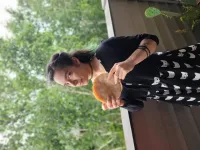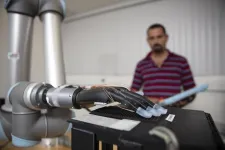(Press-News.org) CORVALLIS, Ore. - Oregon State University scientists are beginning to unravel the key microorganisms that contribute to the fermentation of kombucha, research that is already aiding large-scale kombucha producers in the fast-growing industry.
Kombucha is a fermented tea drink that has been homebrewed around the world for centuries, but in recent years has become widely popular with a global market size expected to grow from $1.3 billion in 2019 to $8.1 billion by 2027, according to an industry report. Several large producers, including Humm and Brew Dr., are based in Oregon.
Kombucha is produced by fermenting sugared tea using a symbiotic culture of bacteria and yeast, commonly referred to as SCOBY, and adding flavorings to enhance the taste. But little is known about what microorganisms in the SCOBY contribute to fermentation, which presents a challenge to kombucha brewers, especially those working on a commercial scale.
"Without having a baseline of which organisms are commonly most important, there are too many variables to try and think about when producing kombucha," said Chris Curtin, an assistant professor of fermentation microbiology at Oregon State. "Now with this research we can say there are four main types of SCOBY. If we want to understand what contributes to differences in kombucha flavors we can narrow that variable to four types as opposed to, say, hundreds of types."
Curtin and Keisha Harrison, a doctoral student in Curtin's lab, recently published a paper in the journal Microorganisms about their kombucha microorganism research, which began in 2017 when Harrison joined the lab.
Harrison gave a presentation about the research at KombuchaKon, an annual technical meeting for the kombucha brewing industry. Her talk caught the attention of representatives from Sierra Nevada Brewing Co., who were looking to launch a line of hard kombucha, Curtin said.
Sierra Nevada launched that line, known as Strainge Beast, in 2020, and recently expanded it with three new flavors. The line uses a proprietary SCOBY culture developed with the Oregon State team, drawing upon results from the recently published paper.
Curtin and Harrison's research follows work by other scientists who have uncovered the microbial communities that contribute to fermentation in other foods and beverages, such as wine, cheese and some types of beer. Past efforts to understand the microbial composition of kombucha have yielded inconclusive results.
In the recently published paper, Curtin and Harrison begin to change that. They used high-throughput DNA sequencing approaches to evaluate the microorganisms in 103 SCOBY used by kombucha brewers, primarily in North America. Only a few studies have applied these techniques with kombucha, and none at this scale.
The major finding was that there are essentially only four main types of SCOBY. Interestingly, each type consisted of very different combinations of yeast and bacteria working together. This contrasts with other fermented beverages, where a single organism consistently becomes dominant, as is the case for beer, wine and cider.
"This is the first comprehensive picture of SCOBY microbial community ecology," Harrison said. "Further research is necessary to relate the microbial community composition of kombucha SCOBY to acidity, flavor and aroma of finished products. That work can now draw upon what we have discovered with the results in this paper."
INFORMATION:
This research was partially funded by the Kombucha Brewers International and the Agricultural Research Foundation at Oregon State.
Vaccine skepticism among young adults may stall efforts to achieve herd immunity - a threshold in which approximately 80 percent of a population is vaccinated against the coronavirus.
A study by UC San Francisco researchers found that about one in four unvaccinated people aged 18 to 25 said that they "probably will not" or "definitely will not" get the COVID-19 vaccination, despite the fact that this demographic has been found to be more likely than other age-groups to transmit coronavirus, jeopardizing the health of older unvaccinated adults and facilitating ...
Each fingertip has more than 3,000 touch receptors, which largely respond to pressure. Humans rely heavily on sensation in their fingertips when manipulating an object. The lack of this sensation presents a unique challenge for individuals with upper limb amputations. While there are several high-tech, dexterous prosthetics available today - they all lack the sensation of "touch." The absence of this sensory feedback results in objects inadvertently being dropped or crushed by a prosthetic hand.
To enable a more natural feeling prosthetic hand interface, researchers from Florida Atlantic University's ...
New data on macaw movements gathered by the Texas A&M University College of Veterinary Medicine & Biomedical Sciences' (CVMBS) The Macaw Society has the potential to greatly improve conservation strategies for the scarlet macaw, as well as similar species of large parrots.
While the overall conservation status of the scarlet macaw is listed as "least concern" by the International Union for Conservation of Nature, the species is declining across much of Central America and in other parts of its range in South America. The species also shares its habitat with numerous endangered species and influences the ecosystems in which ...
The concept of interoperability describes the ability of different systems to communicate. This is a major challenge in biomedical research, and in particular, in the field of personalised medicine, which is largely based on the compilation and analysis of numerous datasets. For instance, the COVID-19 pandemic has shown that even when the technical, legal and ethical constraints are lifted, the data remain difficult to analyse because of semantic ambiguities. Under the auspices of the Swiss Personalized Health Network (SPHN) and in close collaboration with representatives from all five Swiss university ...
Superconductivity is a physical phenomenon where the electrical resistance of a material drops to zero under a certain critical temperature. Bardeen-Cooper-Schrieffer (BCS) theory is a well-established explanation that describes superconductivity in most materials. It states that Cooper pairs of electrons are formed in the lattice under sufficiently low temperature and that BCS superconductivity arises from their condensation. While graphene itself is an excellent conductor of electricity, it does not exhibit BCS superconductivity due to the suppression of electron-phonon interactions. This is also the reason that most 'good' conductors such as gold and copper are 'bad' ...
The corona pandemic has ensured that the term "mRNA" is now also known to a large public beyond laboratories and lecture halls. However, the molecule is much more than an important component of a successful vaccine against the SARS-CoV-2 virus. "mRNAs are a central component of all living things on our planet. Without them life as we know it would not function," says Elmar Wolf.
Wolf is a professor for tumour system biology at the Department of Biochemistry and Molecular Biology at the University of Würzburg. With his research team, he has now deciphered new details about the formation of mRNA which provide novel insights into how a fundamental process inside cells works: the transcription. The team ...
A team of researchers, affiliated with UNIST has succeeded in developing a new optical microscope technology, capable of deeper imaging beyond the biological tissues. This breakthrough has been led by Professor Jung-Hoon Park and his research team in the Department of Biomedical Engineering at UNIST.
Optical imaging technology has emerged as an essential research tool for biomedical studies due to its high resolution and good tomography capability. However, the limited penetration depth of the optical microscope makes it difficult to observe biological tissues of more than 100 μm thickness. This is because strong light scattering, caused by various components ...
New York, NY--July 13, 2021--The past decade has witnessed scandal after scandal over private images maliciously or accidentally made public. A new study from computer scientists at Columbia Engineering reveals what may be the first way to encrypt personal images on popular cloud photo services, such as those from Google, Apple, Flickr and others, all without requiring any changes to -- or trust in -- those services.
Smartphones now make it easy for virtually everyone to snap photos, with market research firm InfoTrends estimating that people now take more than a trillion photos each year. The limited ...
A new study reveals the strategies that stop bandits from illegally fishing in Australian waters--but warns there is a cost to the region's poorer countries.
Co-author Dr Brock Bergseth, from the ARC Centre of Excellence for Coral Reef Studies at James Cook University, said poachers are simply following the recurring history of human fishing: intensively fish and devastate local resources, then move further afield to--in these cases--fish illegally or poach in other countries' waters.
"Millions of people rely on fish and seafood and when offered no alternative choice, will chose banditry and illegal fishing ...
A new method of DNA testing on cocoa beans could revolutionise the chocolate industry, offering consumers greater reassurance about the origins and ethics of their beloved confectionery, and giving the global cocoa industry a precision tool to help end slavery and child labour.
Researchers from the University of Bath, University of the West of England, and Surrey Business School have proven a low-cost method which compares DNA in chocolate products to the cocoa when it is farmed. This means cocoa can be reliably traced back from an individual chocolate bar to the specific farms which cultivated the cocoa in it, a major advance on current fairtrading, certification and sustainability practices.
"This has the potential to ...





